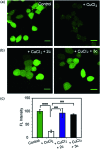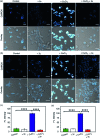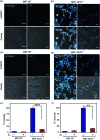Cu2+ selective chelators relieve copper-induced oxidative stress in vivo
- PMID: 30450181
- PMCID: PMC6202919
- DOI: 10.1039/c8sc04041a
Cu2+ selective chelators relieve copper-induced oxidative stress in vivo
Abstract
Copper ions are essential for biological function yet are severely detrimental when present in excess. At the molecular level, copper ions catalyze the production of hydroxyl radicals that can irreversibly alter essential bio-molecules. Hence, selective copper chelators that can remove excess copper ions and alleviate oxidative stress will help assuage copper-overload diseases. However, most currently available chelators are non-specific leading to multiple undesirable side-effects. The challenge is to build chelators that can bind to copper ions with high affinity but leave the levels of essential metal ions unaltered. Here we report the design and development of redox-state selective Cu ion chelators that have 108 times higher conditional stability constants toward Cu2+ compared to both Cu+ and other biologically relevant metal ions. This unique selectivity allows the specific removal of Cu2+ ions that would be available only under pathophysiological metal overload and oxidative stress conditions and provides access to effective removal of the aberrant redox-cycling Cu ion pool without affecting the essential non-redox cycling Cu+ labile pool. We have shown that the chelators provide distinct protection against copper-induced oxidative stress in vitro and in live cells via selective Cu2+ ion chelation. Notably, the chelators afford significant reduction in Cu-induced oxidative damage in Atp7a-/- Menkes disease model cells that have endogenously high levels of Cu ions. Finally, in vivo testing of our chelators in a live zebrafish larval model demonstrate their protective properties against copper-induced oxidative stress.
Figures










Similar articles
-
Antioxidant vs. Prooxidant Properties of the Flavonoid, Kaempferol, in the Presence of Cu(II) Ions: A ROS-Scavenging Activity, Fenton Reaction and DNA Damage Study.Int J Mol Sci. 2021 Feb 5;22(4):1619. doi: 10.3390/ijms22041619. Int J Mol Sci. 2021. PMID: 33562744 Free PMC article.
-
Regulation of copper and iron homeostasis by metal chelators: a possible chemotherapy for Alzheimer's disease.Acc Chem Res. 2015 May 19;48(5):1332-9. doi: 10.1021/acs.accounts.5b00119. Epub 2015 May 6. Acc Chem Res. 2015. PMID: 25946460
-
Cancer Pro-oxidant Therapy Through Copper Redox Cycling: Repurposing Disulfiram and Tetrathiomolybdate.Curr Pharm Des. 2020;26(35):4461-4466. doi: 10.2174/1381612826666200628022113. Curr Pharm Des. 2020. PMID: 32600223
-
Chelation therapy in Wilson's disease: from D-penicillamine to the design of selective bioinspired intracellular Cu(I) chelators.Dalton Trans. 2012 Jun 7;41(21):6359-70. doi: 10.1039/c2dt12188c. Epub 2012 Feb 13. Dalton Trans. 2012. PMID: 22327203 Review.
-
Advances in metal-induced oxidative stress and human disease.Toxicology. 2011 May 10;283(2-3):65-87. doi: 10.1016/j.tox.2011.03.001. Epub 2011 Mar 23. Toxicology. 2011. PMID: 21414382 Review.
Cited by
-
Monitoring nutrients in plants with genetically encoded sensors: achievements and perspectives.Plant Physiol. 2023 Aug 31;193(1):195-216. doi: 10.1093/plphys/kiad337. Plant Physiol. 2023. PMID: 37307576 Free PMC article. Review.
-
Thermoresponsive Behavior, Degradation, and Bioactivity of Nanohydroxyapatite on Graphene Oxide Nanoscroll-Enhanced Poly(N-isopropylacrylamide)-Based Scaffolds.Polymers (Basel). 2025 Jul 23;17(15):2014. doi: 10.3390/polym17152014. Polymers (Basel). 2025. PMID: 40808063 Free PMC article.
-
Copper in cancer: from limiting nutrient to therapeutic target.Front Oncol. 2023 Jun 23;13:1209156. doi: 10.3389/fonc.2023.1209156. eCollection 2023. Front Oncol. 2023. PMID: 37427098 Free PMC article. Review.
-
Critical Review: Propensity of Premise Plumbing Pipe Materials to Enhance or Diminish Growth of Legionella and Other Opportunistic Pathogens.Pathogens. 2020 Nov 17;9(11):957. doi: 10.3390/pathogens9110957. Pathogens. 2020. PMID: 33212943 Free PMC article. Review.
-
The crosstalk between mitochondrial quality control and metal-dependent cell death.Cell Death Dis. 2024 Apr 27;15(4):299. doi: 10.1038/s41419-024-06691-w. Cell Death Dis. 2024. PMID: 38678018 Free PMC article. Review.
References
LinkOut - more resources
Full Text Sources
Other Literature Sources

